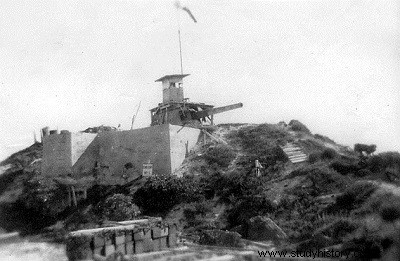
On the island of Betio, the works had lasted more than a year. There was the Japanese headquarters of the Gilbert system and the only airfield in the archipelago, not to mention an incredible accumulation of defenses. The island was five kilometers long and at most 500 meters wide. Its entire shoreline bristled with half-buried gun emplacements, blockhouses and pillboxes (concrete machine gun shelters). Inside, the land left free by the take-off runways had been riddled with stores and underground shelters constituting as many points of support. Most of these works had been made of reinforced concrete and covered with layers of coconut tree trunks and sand, proof against naval projectiles.
To ensure the defense of Tarawa, the counter -Admiral Shibasaki of the 3rd Special Units Force had 1,122 men from this formation and 1,497 marines from Sasebo (7th Group), often (mistakenly) referred to as "Japanese Marines".
In addition to these experienced infantrymen and artillerymen, he could also count on the support of more than 2,000 workers from the construction units, mostly Koreans. To the fires of the infantry were added those of more than twenty coastal guns, ranging from 80 mm to 203 mm, 25 artillery pieces, seven light tanks and a quantity of machine guns. Shibasaki had such confidence in his defensive system that he reportedly declared that "a million Americans, attacking for a hundred years, would fail to take Betio."
It was Admiral Nimitz who was in charge of the operation. He immediately formed the amphibious force he was to use until the end of the war and entrusted Rear Admiral Spruance
responsibility for the operation "Galvanic Rear Admiral Turner received the command of the combined arms expeditionary force and was to lead the attack on one of the two main objectives. The other attack, the one that had Tarawa as its objective, was led by Rear Admiral Hill, while Marine General Smith had under his command all the troops assigned to the 5th Amphibious Corps.
After systematically reviewing intelligence reports and the various means available to “Galvanic”, the number of targets was narrowed down to three atolls:Tarawa, with its essential airfield; Makin, because of its proximity to the Marshalls, and Abemama where it would be possible to set up an airbase near the Gilberts. Reconnaissance by planes and submarines having shown that the hardest piece to remove would be Tarawa, Turner and Smith reserved this objective for their only experienced troops, the 2nd Marine Division, composed mainly of veterans of Guadalcanal and men came to complete them in New Zealand after having received the most advanced training; their motto was:“A launched attack does not stop. »
The capture of Makin had been entrusted to a poorly trained unit, the 165th Infantry Group of the 27th Division. As for Abe-marna, which was known to be poorly defended by the Japanese, the attack was to be carried out by a company of marines from the 5th corps.
In the "war of the atolls", it had to take into account a new element:the crossing of the coral reef that surrounds the islands. The success of an attack from the sea and launched through the knife-edged coral reef flats, over several hundred meters, could only be ensured by the use of tracked amphibious vehicles:the LVTs (landing vehicles, tracked) or amtracks, which had been used until then as equipment transport. The 2nd Division had 75 such boats.
The secret had been well kept. When they left Wellington at the end of October, most of the men of the 2nd Division did not know where they were being sent; they didn't know until they were at sea.
